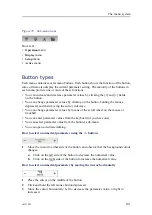
Simrad ES70
You can adjust the TVG setting using the
Echogram
or
TVG
functions. Both are located
on the
Active
menu.
Because the strength of the echoes will become weaker with increasing depth, the echo
sounder will automatically amplify the deepest echoes more than the shallower echoes.
In fact, the gain will increase proportional to how long the echo sounder “waits” for the
echoes. When you choose the TVG setting you can either switch it off (which we do
NOT recommended), or you can choose settings
20 log R
or
40 log R
.
The various settings control the gain algorithms, how much gain to be applied when
the depth increases. When you choose the
40 log R
setting, the gain will increase with
the depth more rapidly than if you choose the
20 log R
setting. This is simply because
individual fishes emit smaller echoes than a school, and this makes them more difficult to
detect. In the equation the character
R
means “Range”.
Figure 37
TVG principle
(CD010217-004)
20 log R
40 log R
A
A
The illustration shows how
the gain close to the bottom
(B) is larger than just below
the transducer (A). The echoes
from the fish close to the
bottom will then be shown with
the same strength (colour) as
echoes from pelagic fish.
The left vessel uses the
20 log
R
setting. Due to the increasing
beam width (C), single fishes
are shown larger and larger with
increasing depth, even though
they may be of identical size.
The right vessel uses the
40 log
R
setting. The size of the fish
will still appear to grow larger
as the range increases, but the echo is compensated differently to offer a more uniform
echo strength (colour in the echogram).
When you are looking for schools these will fill the entire beam, just as the bottom
normally does. A lot of gain is then not necessary. The
20 log R
setting will provide an
acceptable echo strength.
110
343539/B
Summary of Contents for ES70 - DOWNLOAD AND INSTALLATION REV B
Page 2: ......
Page 128: ...ISBN 13 978 82 8066 118 0 2010 Kongsberg Maritime AS ...































